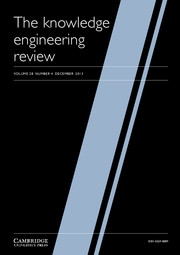Article contents
Exploiting personal web servers for mobile context-aware applications
Published online by Cambridge University Press: 21 March 2014
Abstract
There is an increasing trend in moving desktop applications to web browsers, even when the web server is running on the same desktop machine. In this paper, we go further in this direction and show how to combine a web server, a web application framework (enhanced to support desktop-like Model–View–Controller interaction) and a context-aware architecture to develop web-based mobile context-aware applications. By using this approach we take advantage of the well-established web paradigm to design the graphical user interfaces (GUIs) and the inherent ability of the web to mash up applications with external components (such as Google Maps). On top of that, since the web server runs on the device itself, the application can access local resources (such as disk space or sensing devices, which are indispensable for context-aware systems) avoiding the sandbox model of the web browsers. To illustrate our approach we show how a mobile hypermedia system has been built on top of our platform.
Information
- Type
- Articles
- Information
- Copyright
- Copyright © Cambridge University Press 2014
References
- 4
- Cited by

